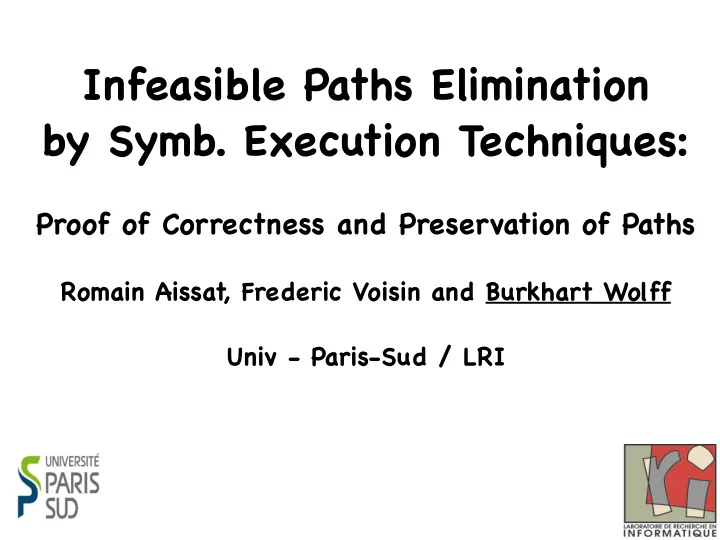

Infeasible Paths Elimination by Symb. Execution Techniques: Proof of Correctness and Preservation of Paths Romain Aissat, Frederic Voisin and Burkhart Wolff Univ - Paris-Sud / LRI 1
Abstract TRACER [8] is a tool for verifying safety properties of se- quential C programs. TRACER attempts at building a finite symbolic execution graph which over-approximates the set of all concrete reach- able states and the set of feasible paths. We present an abstract framework for TRACER and similar CEGAR-like systems [2, 3, 5, 6, 9]. The framework provides 1) a graph-transformation based method for reducing the feasible paths in control-flow graphs, 2) a model for symbolic execution, subsumption, predicate abstraction and invariant generation. In this framework we formally prove two key properties: correct construction of the symbolic states and preservation of feasible paths. The framework focuses on core operations, leaving to concrete prototypes to “fit in” heuristics for combining them.
Introduction: Control Flow Paths(CFG) ● A simple C program and its control-flow graph 1 1 void f(int x, bool b) 3: init() 2 { 3 init(); 4 4 while (x > 0){ 5 if(b) 5 6 {P(&x); } 7 else 6: P(&x) 8: Q(&x); 8 {Q(&x);} 9 return (x==0); 9 10 } Paths of max 2 loop traversals: {[1,3,4,9], [1,3,4,5,6,4,9], [1,3,4,5,8,4,9], [1,3,4,5,6,4,5,6,4,9], [1,3,4,5,8,4,5,8,4,9],[1,3,4,5,6,4,8,4,9], [1,3,4,5,8,4,5..]}
Introduction : Control Flow Paths ● Not all paths in the CFG are actually feasible , i.e. possible wrt. to the operational semantics for concrete input values for x and b . ● Actually, [1,3,4,5,6,4,8,4,9], [1,3,4,5,8,4,5,6,4,9] are infeasible , ie no input exists that makes this execution possible (assuming C semantics)
Introduction : Control Flow Paths ● Worse : number of paths with k loop traversals : 2 k number of feasible paths ¨ ¨ ¨ : 2 * k So, the probability for picking randomly a feasible path decreases asymptotically to 0 ● Even worse: experiments show, that this gap is typical in practical programs. This is the source of inefficiency of many static analysis techniques: symb exec testing, abstract interpretation, random testers ...
Introduction: Blue Calculus ● Remedy: Transformation of the CFG 1 1 3: init() 3: init() 4 5 5 4 4’ 6: P(&x) 6: P(&x) 8: Q(&x); 8: Q(&x); 9 9 After transformation: No infeasible paths any more . . .
Contributions Rational Reconstruction of TRACER ● [Jaffar et al, CAV12] into a formal model ATRACER ATRACER presents TRACER by 6 (non-deterministic) ● Graph-Transformation Rules on Red-Black-Graphs * Proof in Isabelle/HOL: ● Derivations in ATRACER preserve semantics Proof in Isabelle/HOL: ● feasible paths should be preserved There should be less infeasible paths in general ** ● * no heuristics modeled **which is experimentally confirmed, but we can’ t give strong guarantees
Red-Black Graphs 1 lock=0; new=old+1 2 while(new!=old){ 3 k=1; old=new 4 if(*){lock=0; new=new+1;} 6 }; 7 if (lock==0) 8 error() Graph Transformation Rules: 1) init ... 8
Red-Black Graphs * * Graph Transformation Rules: ... 2) symbolic execution assign 3) symbolic execution assume 4) abstraction 9 5) subsumption 6) cut - rule (for infeasible paths)
Formalisation ● Tasks: ● Red-Black Graphs, Paths, Fringes ● Labelled Transition Systems ● States, Configurations, Symbolic Execution ● Formalizing Graph Transformation Step Relation as Inductive Definition ● Proof of Correctness and Preservation 10
Formalisation (1) ● Basic Machinery Raw graphs, labelled transition systems: – – – coherent arc sequences – paths 11
Formalisation (2) ● Execution Data: states, stores, (shallow) expressions : – – framing : – program expressions as core syntax : 12
Formalisation (3) ● Red-Black-Graphs: – – red part – black part – the set of subsumption links – initial configuration (contains precondition if any) – mapping for symbolic variables to additional constraints 13
Formalisation (4) ● Example (out of 6): Symbolic Execution. ui_arc ra, the (unindexed) black counterpart of red arc ra must exist in the black graph, – ArcExt.extends is an abbreviation that states that the source of ra must be an existing vertex – of the red graph, but not its target, and that the new red graph is obtained by adding ra to the arcs of the old one, the source of ra is is not already subsumed, – c ′ is the new configuration obtained by symbolic execution of ra – 14 the new red-black graph rb ′ is constructed from the old one by the resp. updates –
Formalisation (5) ● The Blue Calculus: 15
Proof (1) ● Lemma: red paths lead always to weaker configurations: ● Lemma: All red-black sub-paths included in the corresponding “pure black” path-sets: 16
Proof (2) ● Main Result: all feasible paths were preserved by the “blue calculus”: 17
Development Effort ● Effort for entire theory development: – 12 theories, – 7932 loc – main proof: 2000 loc Isar-style highly struc- tured proof – proof techniques: standard in- duction proofs; but many, many cases to consider 18
Experimental Evaluation(1) ● The framework was implemented in an OCaml prototype, providing also some first heuristics. ● Mergesort: 19
Experimental Evaluation(2) ● Bubblesort: 20
Conclusion ● first known formal proof for a predicate abstraction framework. ● available in AFP soon. ● widely appliquable for enhancements many static analysis techniques ● Main difficulty: working on graphs and giving it enough inductive structure: red part, blue calc. ● Many open research problems, including heuristics, code-generation, calls in the labelling language. 21
Recommend
More recommend